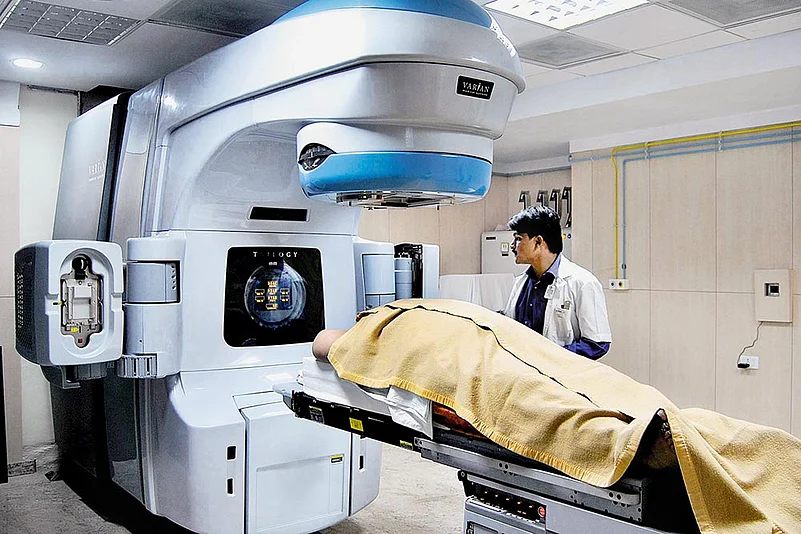A silent assasin is stalking us more virulently than ever, especially our young, but to quote from Aleksandr Solzhenitsyn’s Cancer Ward, “you can have eyes and still not see”. It’s cancer, the second leading cause of death after cardiovascular diseases in India. Going by an estimate deduced from registered incidences since 2004, cancer cases in all age groups in the county is expected to reach 819,354 by the yearend. But the scarier bit, a cause of concern, is that cancer among adolescents and young adults—those between 15 and 29 years generally, and bundled under the abbreviation AYA—has risen over the years. An exact number isn’t available as data is still being collected. The volume could be significant because in a country of nearly 1.3 billion people, about 55 per cent of the population is below 35, and around 30-40 per cent of them are in the adolescent bracket.
Cancer in the AYA group is unique in the distribution of types as well as what it does to patients psychologically. As per Globocan 2018, International Agency for Research on Cancer, World Health Organization (WHO), the commonest cancers in this group are leukaemia (blood), germ cell tumour of the ovary, thyroid, oral, Hodgkin’s lymphoma, testicular, female genital tract malignancies, and bone sarcomas. A study from 2011 to 2014 on cancer patterns among 1,077 AYA cases at a tertiary care in northern India and published in South Asian Journal of Cancer in 2017 found that the most common was head and neck (32 per cent), followed by breast (14.2 per cent). “Cancer has the greatest impact on individuals from this group because it occurs when they are most productive. They suffer from adverse psychosocial effects because most of their potential years are spent battling cancer. This also puts a large economic burden on society,” says Ravi Mehrotra, chief executive officer, India Cancer Research Consortium.
Problem is cancers in the AYA group are often mistaken initially for infectious diseases. Thus diagnosis and treatment get delayed. That’s because people hardly suspect a kid could have the disease, although oral cancer is most common in this group in India. On the positive side, Dr Anurag Srivastava, professor and head, department of surgical disciplines, AIIMS, Delhi, says the survival of adolescents with leukaemia and lymphomas has dramatically improved over the past decade.
Our modern lifestyle—sedentary and unhealthy practices like smoking, drinking and binge-eating processed food et al—is perhaps the biggest cause of cancer. Citing their national study published in Lancet in 2018, preventive oncologist Mehrotra says tobacco-use among young adults would be the single-most preventable cause because a smoker, for instance, may not have cancer at a young age but is at the highest risk in a couple of decades of smoking. “Other than tobacco, alcohol and areca nut or supari are some specific reasons, particularly in urban and semi-urban areas…Something people don’t talk about is obesity as a cause. The number of younger obese children, as young as 10 or 15 or even younger, is something to be noted. When we have obesity, we are automatically about 12 or 13 times more susceptible to cancer.” Obesity is linked to oesophagus, colorectal and breast cancers, among others.

Some experts are ‘non-committal’ on the reported spurt in cancer cases among the young and aren’t quite sure if poor lifestyle is a cause. Ramandeep Singh Arora, paediatric oncologist at Max Super Specialty Hospital, explains that increase in recognition of a disease, diagnosis and access to healthcare have contributed to better reporting of cancer cases. “The younger you are the impact of lifestyle is negligible. But as you grow older, the impact of lifestyle and environment is more. In the case of AYA, the impact is a combination of environment and genetics,” he says.
Whatever may be the cause, experts are worried about the rise in cancer cases. “The incidence of cancer in India is unfortunately on a rising trend, the highest being in the states of Kerala and Mizoram. A committed epidemiological and scientific research is the need of the hour to find the cause of this alarming rise and prompt measures need to be initiated for prevention rather than therapy, particularly in the context of a developing country with limited resources,” says Dr M.I. Sahadulla, chairman and managing director, KIMS Global Cancer Care, Thiruvananthapuram.
According to the WHO, 30-50 per cent cancers are preventable. Experts state that prevention offers the most cost-effective long-term strategy. They prescribea healthy lifestyle, regular physical activity, a good body mass index and weight, a nourishing diet considerably reduce susceptibility to cancer and other diseases. Diets high in fruits and vegetables may have an independent protective effect against many cancers. Quitting smoking can prevent cancers of the lung, oesophagus, larynx, mouth, throat, kidney, bladder, pancreas, stomach and cervix. Smokeless tobacco like khaini causes oral, oesophageal and pancreatic cancers. Avoiding excessive exposure to the sun’s carcinogenic UV rays and use of sunscreen can prevent skin cancers such as melanoma. Vaccination against the hepatitis B virus reduces the risk of liver cancer, while the vaccine for the human papilloma virus (HPV) helps decrease the risk of cervical cancer.

Actress, author Lisa Ray is a cancer survivor. She was diagnosed with multiple myeloma in 2009, aged 37 then.
Breast cancer is the commonest among women, accounting for 24.2 per cent or about 2.1 million cases worldwide, according to Globocan 2018. India had 162,468 new breast cancer cases in 2018. Dr Rajan, director of clinical services, KIMS in Kerala, reveals that Indian patients with breast cancer are a decade younger compared to counterparts in developed countries, where it is in the 55-65 age group normally. “We don’t know the reason for this spike and early prevalence,” the specialist says. Dr Anurag Srivastava of AIIMS, Delhi, has a similar revelation. According to him, an ICMR study has found that the annual rise in breast cancer cases among women aged 15 to 34 is 4.24 per cent, 1.6 per cent and 0.80 per cent in Nagpur, Mumbai and Chennai. Whereas the increase for the 35–44 age group is from 0.37 per cent to 2.97 per cent. “In our own data, we had 7.1 per cent women below 30 years,” he says.
Several risk factors for breast cancer are known, including inherited genes and reproductive aspects such as early menarche, shorter menstrual cycle, late menopause besides nulliparity, child birth at a young age. “The reproductive factors are linked to greater lifetime exposure to endogenous ovarian hormones. These ovarian hormones initiate breast development and may also lead to growth of mutated cells,” Srivastava says. Dietary factors like excessive intake of saturated fat, carbs and red meat, and weight gain during adulthood, increase breast cancer risk. There is substantial evidence that alcohol consumption also heightens the risk.
Srivastava says AIIMS is taking the fight against breast cancer beyond the OPDs, labs and wards. It is imparting training to medical officers and auxiliary nurses and midwives from all states in collaboration with the government’s National Health Mission. The institution also conducts a breast cancer screening camp, aside from a weekly clinic at the National Institute of Cancer Prevention and Research in Noida. Awareness in rural areas is spread through an animated movie that AIIMS had made and got it dubbed in multiple languages. It tells about symptoms and the right way to do self-examination of the breasts. AIIMS has started a super-specialisation course in breast and endocrine diseases, which is an established speciality in the West.
Cancer cure has surely improved in the past decades. The newest hope is genome. Dr B.S. Ajaikumar, chairman and CEO of HealthCare Global Enterprises Limited, feels “cancer genomics research has enormous, untapped potential. Genomics research is the basis for genomic medicine, which is a relatively new branch of medicine, where doctors use a person’s genetic information to choose the best possible line of treatment and cancer care”. The need for innovative approaches is getting a new thrust. The India Cancer Research Consortium (ICRC) offered in October funds up to Rs 1.5 crore for three years to invite best research ideas in six thematic areas—prevention and epidemiology, diagnostics, therapeutics, palliative care, basic biology and innovation. The objective is to produce outcomes that can be put into practice. A breakthrough, no doubt, will be a boon to thousands of patients and their families. Until then, to quote Siddhartha Mukherjee’s The Emperor of All Maladies, cancer will remain “a pathological mirror of our own”.
















